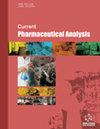用于制备奥沙利铂纳米颗粒的奥沙利铂药物估算 RP-UFLC 方法的开发与验证
IF 1.5
4区 医学
Q4 PHARMACOLOGY & PHARMACY
引用次数: 0
摘要
背景:奥沙利铂是一种铂类抗肿瘤药物,被广泛用于治疗结直肠癌。众所周知,奥沙利铂能通过生成 DNA 加合物阻碍细胞(尤其是癌细胞等快速分裂的细胞)的发育和分裂。目前公布的奥沙利铂分析方法需要复杂、难以理解的程序,而且成本高昂。研究目的我们研究的主要目的是选择色谱参数、开发超高效液相色谱法并进行验证,以及根据 ICH 指南验证结果。方法:在这项超高效液相色谱研究中,使用了正相 C18 色谱柱(250 厘米 x 4.6 毫米 x 5 微米),流动相为 0.01 M 正磷酸和乙腈(95:5 V/V),pH 值为 3.5。流速固定为 1 毫升/分钟,样品在紫外检测范围内进行检测。该方法已通过精密度、线性、强制降解研究、稳健性和准确性验证。结果:药物的保留时间为 8 分钟。药物的校准曲线范围为 10-240 μg/ml。该分析结果已根据 ICH 指南 Q2 (R1) 进行了人体使用注册验证。结论与标准高效液相色谱法相比,我们所采用的超高效液相色谱法用于奥沙利铂的定量分析,不仅操作简单、易于理解,而且成本效益更高,因为它所消耗的流动相和时间更少。因此,我们可以得出结论,这种简单易行的新方法可以替代现有的奥沙利铂标准方法。本文章由计算机程序翻译,如有差异,请以英文原文为准。
Development and Validation of an RP-UFLC Method for the Estimation of Oxaliplatin Drug for the Preparation of Oxaliplatin Nanoparticles
Background: Oxaliplatin, a platinum-based antineoplastic agent, is widely used to treat colorectal cancer. It is well-known for its capacity to hinder the development and division of cells, especially fast-dividing ones, like cancer cells, via the creation of DNA adduct. The currently published oxaliplatin analytical methods require a complex, difficult-to-understand procedure, and are costly. Objective: The main objectives of our study were to select the chromatographic parameters, develop a UFLC method and validate it, and validate the results according to ICH guidelines. Method: In this UFLC study, a normal phase C18 column (250cm x 4.6 mm x5 μm) with a mobile phase containing 0.01 M orthophosphoric acid and acetonitrile (95:5 V/V) has been used at pH 3.5. Flowrate has been fixed at 1ml/min and the sample has been tested in the UV range for detection. The methods have been validated for precision, linearity, forced degradation studies, robustness, and accuracy. Results: The retention time of the drug has been found to be >8min. The calibration curve of the drug has been obtained within the range of 10–240 μg/ml. The results of this analysis have been validated according to ICH guideline Q2 (R1) for registration of human use. Conclusion: The UFLC method we have used for oxaliplatin quantification has been found to be simpler, easier to understand, and more cost-effective than standard HPLC as it has consumed less mobile phase and less time. Thus, we can conclude that this new, simple, and easy method may be a useful alternative to the existing standard methods for oxaliplatin.
求助全文
通过发布文献求助,成功后即可免费获取论文全文。
去求助
来源期刊
CiteScore
1.50
自引率
0.00%
发文量
85
审稿时长
3 months
期刊介绍:
Aims & Scope
Current Pharmaceutical Analysis publishes expert reviews and original research articles on all the most recent advances in pharmaceutical and biomedical analysis. All aspects of the field are represented including drug analysis, analytical methodology and instrumentation. The journal is essential to all involved in pharmaceutical, biochemical and clinical analysis.

 求助内容:
求助内容: 应助结果提醒方式:
应助结果提醒方式:


